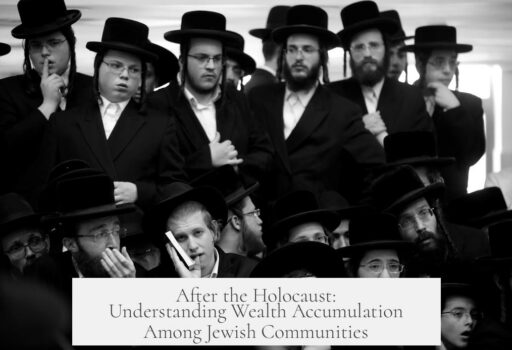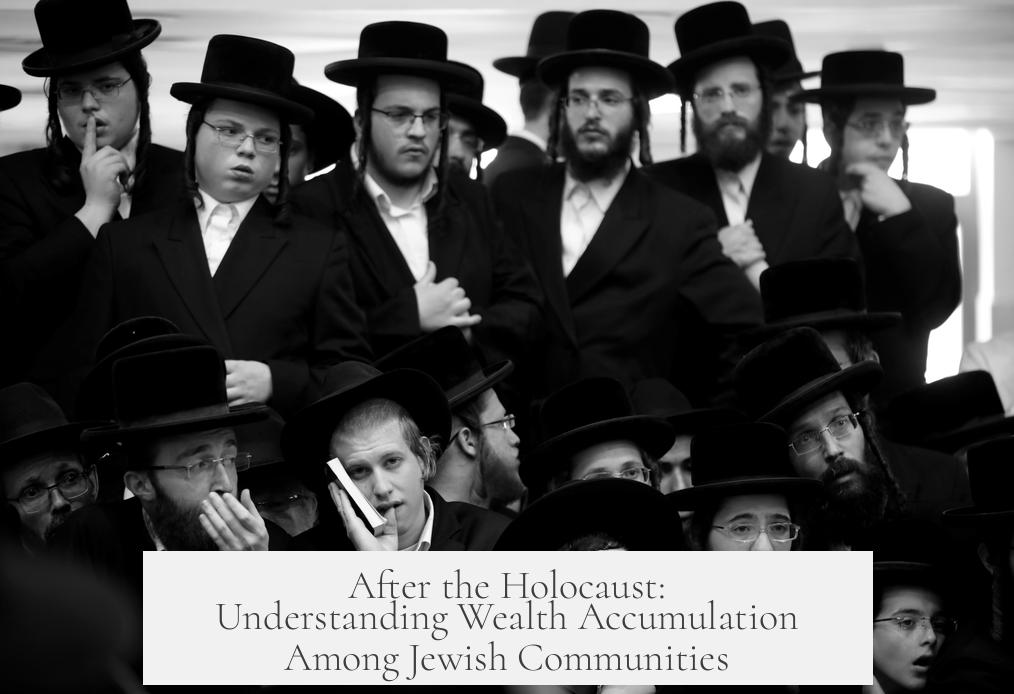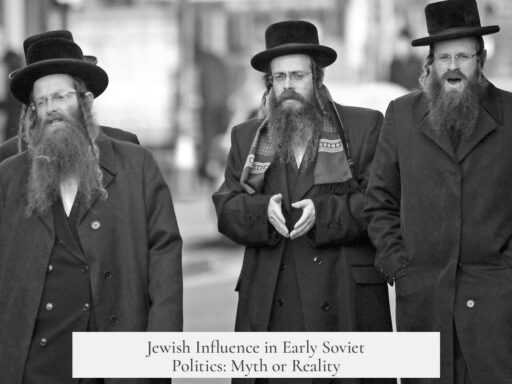The Jewish people did not uniformly “gain wealth” after the Holocaust; rather, Jewish wealth patterns reflect complex historical, social, and economic factors predating and following World War II. The belief that Holocaust survivors collectively became wealthy afterward is a misconception rooted in misunderstanding demographic and historical realities. Jewish communities were diverse, with varying socioeconomic statuses before, during, and after the Holocaust.

The Holocaust devastated Jewish populations across Europe, wiping out millions and seizing vast amounts of property and assets. However, it disproportionately affected poorer Jews left behind in ghettos, while wealthier Jews often emigrated before or during the war. Many who escaped had the resources to relocate, preserving part of their wealth. Survivors often faced significant economic hardship, having lost their homes and livelihoods. In many cases, Jewish wealth was confiscated by Nazi regimes and often never fully restored.
Significantly, large Jewish populations outside Holocaust-affected areas such as the United States, Switzerland, Portugal, Spain, Italy, and Sweden remained economically stable and unaffected by wartime seizures. For example, the U.S. Jewish community, numbering over four million by 1927, did not suffer the direct financial losses Europeans endured. Wealthy Jews in these countries continued to build their assets independent of Holocaust impacts.

Long before the Holocaust, Jewish communities had established professional niches conducive to wealth accumulation. Centuries of exclusion from land ownership, guilds, and public office led many Jews to focus on banking, finance, and trade. For example, Jewish banking traditions date back to medieval Europe when Catholic laws prohibited Christians from charging interest (usury). Jews filled this economic gap and developed expertise in managing finance.
Investment and banking careers offered portability and security—valuable for a people often facing persecution. Such roles allowed for movable assets like gold and financial instruments, enabling protection of wealth across borders. This tradition of financial acumen endured and evolved. Many historic European and later American banks trace roots to Jewish founders or families.

Education plays a central role in Jewish economic success. Jewish tradition emphasizes literacy and study from an early age. This extends beyond religious texts, fostering high educational attainment in secular fields. Statistics show Jewish individuals often surpass national averages in education levels, particularly in the United States. Higher education facilitates access to professional, managerial, and entrepreneurial opportunities.
Social barriers and antisemitism declined notably in North America during the latter half of the 20th century. This decline opened new economic doors previously closed to Jewish individuals. Combined with the rise of post-war capitalism and the knowledge economy, Jewish professionals and entrepreneurs leveraged their education and networks to establish businesses and careers in diverse industries.

It is essential to recognize Jewish wealth is not monolithic. Socioeconomic diversity exists within Jewish communities globally. For instance, Orthodox and ultra-Orthodox communities may have different educational and economic profiles than secular Jewish populations. Wealth disparities within cities such as New York demonstrate the broad economic spectrum among Jews.
In summary, several points clarify the perception of Jewish wealth post-Holocaust:

- The Holocaust caused immense loss of life and wealth among European Jews, primarily affecting poor and middle-class families remaining in Nazi-occupied regions.
- The wealthiest Jews often emigrated before or during the war, preserving some assets and founding new economic success in safer countries.
- Jewish economic strength is deeply rooted in centuries-old traditions of finance, trade, and education, not a direct consequence of post-Holocaust conditions.
- Jews outside Europe, mainly in the U.S. and parts of Western Europe, continued building wealth largely independent of the Holocaust’s direct impact.
- Declining antisemitism and expanded educational opportunities in the post-war period enabled new economic advances.
- Jewish communities exhibit wide economic diversity; wealth is not evenly distributed nor universally attained.
This nuanced understanding dispels myths about a singular Jewish economic experience after the Holocaust. Jewish wealth today results from historical continuity, cultural emphasis on education, strategic adaptation to social constraints, and responding to opportunities in evolving economic landscapes.
Serious Question: After the Devastating Holocaust, How Did the Jewish People Gain So Much Wealth?
Let’s address the question head-on: The wealth of many Jewish communities today after the Holocaust isn’t a simple tale of survivors bouncing back richer than before. It’s a complex story about history, migration, education, opportunity, and often mistaken assumptions.
Now that the main answer is out of the way, it’s worth digging deeper. Because the idea that Jewish wealth came as an immediate rebound from Holocaust survivors is a myth.
Assumptions vs. Reality: Holocaust Survivors and Wealth
First, it’s important to clarify: you are probably assuming that modern Jewish billionaires sprang straight from the pockets of Holocaust survivors. That assumption doesn’t hold up to scrutiny.
Here’s why—it ignores the big picture. Many Jewish communities, especially the 4.3 million Jews living in the United States back in 1927, were largely unaffected by the Holocaust itself. These populations did not endure the same scale of financial devastation.
So, the wealthy Jewish individuals you hear about today — their lineage, wealth, and success often trace back to communities not directly devastated economically by the Holocaust.
Historical Roots: Why Finance and Investment?
Watch this: Europe’s history shaped much of Jewish economic life. The Catholic Church once banned Christians from charging interest—usury was a mortal sin. However, Jews were exempt from these rules, opening a door uniquely for them to specialize in banking and lending.
Since Jews were often barred from owning land, joining guilds, or holding public office, finance became one of the few viable economic avenues. It’s a classic example of necessity shaping opportunity.
Toss in the Reformation, which relaxed the Church’s stance on interest for everyone, and what do you get? A Jewish community already well-established in money management, positioned for lasting success in banking and investment.
Indeed, many major banks today trace their origins to Jewish founders. That’s historical groundwork for wealth accumulation, not a quick comeback story.
Portability of Wealth: A Matter of Survival
One interesting factor is what you might call economic “nimbleness.” Jewish communities historically faced frequent upheaval—from pogroms to forced expulsions. This caused a deep cultural preference for portable and secure forms of wealth.
Bank accounts, financial instruments, goldsmithing—these were assets easy to carry or transform if escape became necessary. This isn’t just about smart investing. It’s survival instinct built into financial choices.
Imagine being ready to move at a moment’s notice. How do you carry the family fortune? Liquid, portable assets make perfect sense.
The Holocaust’s Impact: Who Was Affected Financially?
While the Holocaust brutally stripped many Jews in German-occupied Europe of assets and life itself, the story isn’t uniform.
Many assets that could be recovered were returned after the war. But more importantly, significant Jewish populations in places like Portugal, Spain, Italy, Sweden, Switzerland, and the United States essentially avoided direct impact.
Those Jewish people left behind—often poorer communities confined in ghettos—were disproportionately the Holocaust’s victims. Wealthier Jews frequently emigrated before or during the early years of the Nazi regime, escaping the worst financial damage and physical danger.
This division means post-war Jewish wealth statistics reflect not a rebuild from ashes but rather economic realities shaped by who survived where and who left when.
Education: The Undeniable Edge
What really stands out in Jewish economic success is a *sustained* cultural emphasis on education and literacy.
Judaism expects men to read scriptures, reflecting literacy ingrained in religious practice. This carries over into modern times, where Jewish populations often surpass Americans in average years of schooling by a significant margin.
As a striking example, nearly a third of current U.S. Supreme Court Justices are Jewish. That’s not luck; it’s a pattern demonstrating the returns from education.
Higher education then translates into professions with economic power—law, medicine, finance, academia, and entrepreneurship.
Fading Barriers: New Doors After the Holocaust
The decline of antisemitism in many parts of North America after WWII unlocked opportunities once closed.
Strong educational backgrounds combined with a capitalist boom and the rise of the knowledge economy created fertile soil for Jewish entrepreneurial and professional success.
This was less about “wealth regained” and more about wealth created anew in an environment increasingly free from historic discrimination.
The Myth of Uniform Wealth
One big misconception is that all Jews are affluent. Reality check: the Jewish community is economically diverse.
Within cities like New York, you’ll find ultra-Orthodox Jews in Brooklyn living modestly and often without the college education tradition common in other Jewish groups.
So no, Jewish wealth is not a monolith. It varies by community, religious practice, and opportunities seized over time.
Putting It All Together: Holocaust and Wealth Data
To wrap it up simply: those Jews who were victims of the Holocaust largely lost wealth and life — meaning they don’t drive the statistics for wealth in other Jewish populations around the world.
What you see today is the average economic standing of individuals mostly outside the European Holocaust epicenter.
Mix together:
- Historical specialization in finance due to religious and social restrictions.
- A cultural premium on education and literacy.
- Selective survival and emigration before and after the Holocaust.
- The lifting of antisemitism barriers in North America.
- The diversity of socioeconomic statuses within Jewish communities.
The result? **A complex, multifaceted explanation for modern Jewish wealth that has less to do with “rebuilding after the Holocaust” and more with a combination of history, culture, migration, and opportunity.**
So, Why Does This Matter?
Understanding this dispels myths and combats stereotypes about Jewish people and wealth. It reminds us that history is nuanced. Socioeconomic success arises from a patchwork of factors, not simplistic stories.
Next time you hear the stereotype about Jewish wealth “booming” immediately after WWII, remember the actual narrative:
This is a tale of centuries of specialized knowledge, cultural resilience, migration strategies, and luck in timing—**not a secret formula or overnight rebound.**
What’s your take? Have you come across other communities whose economic stories challenge popular assumptions? Let’s discuss below!
Why is it incorrect to assume most wealthy Jewish people today are Holocaust survivors or their descendants?
Most Jewish billionaires are not directly descended from Holocaust survivors. Many Jews outside Europe, such as those in the USA, were not financially affected by the Holocaust.
How did historical restrictions on jobs for Jews influence their wealth-building activities?
Jews were often barred from owning land or joining guilds. This pushed them toward banking and investment, areas allowed for them and historically profitable.
Did the Holocaust completely destroy Jewish wealth?
The Holocaust caused major losses, but many assets were returned after the war. Also, Jews in countries like the USA and Switzerland were mostly untouched by these losses.
What role does education play in Jewish economic achievements?
Education has been a core value in Jewish culture. Literacy and advanced education helped many Jews succeed in professional and financial fields.
How did emigration before and after WWII affect wealth distribution among Jews?
Richer Jews often emigrated, escaping harsh anti-Jewish environments. Those left behind were often poorer, shaping different economic outcomes within Jewish communities.
Has the decline of antisemitism contributed to Jewish economic success?
Less antisemitism in North America opened new opportunities. Coupled with education and post-war economic growth, this benefitted many Jews economically.




